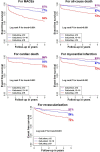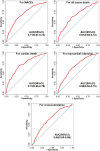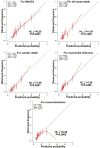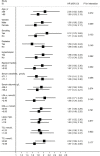The predictive value of CatLet© angiographic scoring system for long-term prognosis in patients with acute myocardial infarction presenting > 12 h after symptom onset
- PMID: 36211570
- PMCID: PMC9532528
- DOI: 10.3389/fcvm.2022.943229
The predictive value of CatLet© angiographic scoring system for long-term prognosis in patients with acute myocardial infarction presenting > 12 h after symptom onset
Abstract
Background: We have recently developed the C oronary A rtery T ree description and L esion E valua T ion (CatLet©) angiographic scoring system, which is capable of accounting for the variability in coronary anatomy, and risk-stratifying patients with coronary artery disease. This study aimed to clarify whether the CatLet score had a predictive value for long-term prognosis in patients with acute myocardial infarction (AMI) presenting > 12 h after symptom onset.
Materials and methods: The CatLet score was calculated for 1,018 consecutively enrolled AMI patients, who were divided into 3 groups according to the CatLet score tertiles. The primary endpoint was major adverse cardiac events (MACEs), defined as a composite of myocardial infarction, cardiac death, and ischemia-driven revascularization; secondary endpoints were all-cause death, cardiac death, myocardial infarction, and ischemia-driven revascularization.
Results: The CatLet score was capable of predicting long-term prognosis at a median 4.9-year follow-up alone or after adjustment for risk factors. Multivariable-adjusted hazard ratios (95% CI)/unit higher score were 1.06 (1.05-1.08) for MACEs, 1.05 (1.03-1.07) for all-cause death, 1.06 (1.04-1.09) for cardiac death, 1.06 (1.04-1.08) for myocardial infarction, and 1.06 (1.04-1.08) for revascularization. The univariate model showed good calibration (χ2 = 8.25, P = 0.4091) and good discrimination (area under ROC curve = 0.7086) for MACEs.
Conclusion: The CatLet score is an independent predictor of long-term clinical outcomes of patients with AMI presenting > 12 h after symptom onset (http://www.chictr.org.cn; Registry Number: ChiCTR2000033730).
Keywords: Percutaneous Coronary Intervention; acute myocardial infarction; angiographic score; major adverse cardiac events; prognosis.
Copyright © 2022 Wang, He, Fan, Li, Zhou, Jiang and He.
Conflict of interest statement
The authors declare that the research was conducted in the absence of any commercial or financial relationships that could be construed as a potential conflict of interest.
Figures




Similar articles
-
Revisit of the CatLet (Hexu) angiographic scoring system: a narrative review.J Thorac Dis. 2023 May 30;15(5):2848-2858. doi: 10.21037/jtd-22-1642. Epub 2023 Apr 20. J Thorac Dis. 2023. PMID: 37324066 Free PMC article. Review.
-
CatLet score and clinical CatLet score as predictors of long-term outcomes in patients with acute myocardial infarction presenting later than 12 hours from symptom onset.Ann Med. 2024 Dec;56(1):2349190. doi: 10.1080/07853890.2024.2349190. Epub 2024 May 13. Ann Med. 2024. PMID: 38738420 Free PMC article.
-
The Predictive Value of the CatLet Scoring System for Long-Term Prognosis After Percutaneous Coronary Intervention in Patients With Chronic Coronary Syndrome.Catheter Cardiovasc Interv. 2025 Feb;105(2):283-291. doi: 10.1002/ccd.31191. Epub 2024 Nov 6. Catheter Cardiovasc Interv. 2025. PMID: 39506497
-
The CatLet score and outcome prediction in acute myocardial infarction for patients undergoing primary percutaneous intervention: A proof-of-concept study.Catheter Cardiovasc Interv. 2020 Sep 1;96(3):E220-E229. doi: 10.1002/ccd.28724. Epub 2020 Jan 14. Catheter Cardiovasc Interv. 2020. PMID: 31943728
-
Serum cystatin C is associated with the prognosis in acute myocardial infarction patients after coronary revascularization: a systematic review and meta-analysis.BMC Cardiovasc Disord. 2022 Apr 7;22(1):156. doi: 10.1186/s12872-022-02599-5. BMC Cardiovasc Disord. 2022. PMID: 35392813 Free PMC article.
Cited by
-
Revisit of the CatLet (Hexu) angiographic scoring system: a narrative review.J Thorac Dis. 2023 May 30;15(5):2848-2858. doi: 10.21037/jtd-22-1642. Epub 2023 Apr 20. J Thorac Dis. 2023. PMID: 37324066 Free PMC article. Review.
-
Residual coronary artery tree description and lesion EvaluaTion (CatLet) score, clinical variables, and their associations with outcome predictions in patients with acute myocardial infarction.Chin Med J (Engl). 2023 Oct 20;136(20):2459-2467. doi: 10.1097/CM9.0000000000002640. Epub 2023 Apr 12. Chin Med J (Engl). 2023. PMID: 37052135 Free PMC article.
-
Catlet scoring system as a new predictor for in-stent restenosis in patients with chronic coronary artery disease undergoing percutaneous coronary intervention with drug-eluting stent.J Cardiothorac Surg. 2025 Jan 29;20(1):106. doi: 10.1186/s13019-025-03349-2. J Cardiothorac Surg. 2025. PMID: 39881392 Free PMC article.
-
Coronary Artery Tree Description and Lesion Evaluation (CatLet) score for functional evaluation of coronary stenosis: a comparison study with pressure wire fractional flow reserve.Quant Imaging Med Surg. 2024 Apr 3;14(4):2857-2869. doi: 10.21037/qims-23-1635. Epub 2024 Mar 15. Quant Imaging Med Surg. 2024. PMID: 38617154 Free PMC article.
-
CatLet score and clinical CatLet score as predictors of long-term outcomes in patients with acute myocardial infarction presenting later than 12 hours from symptom onset.Ann Med. 2024 Dec;56(1):2349190. doi: 10.1080/07853890.2024.2349190. Epub 2024 May 13. Ann Med. 2024. PMID: 38738420 Free PMC article.
References
-
- van Nunen LX, Zimmermann FM, Tonino PA, Barbato E, Baumbach A, Engstrøm T, et al. Fractional flow reserve versus angiography for guidance of PCI in patients with multivessel coronary artery disease (FAME): 5-year follow-up of a randomised controlled trial. Lancet. (2015) 386:1853–60. - PubMed
-
- De Bruyne B, Pijls NH, Kalesan B, Barbato E, Tonino PA, Piroth Z, et al. Fractional flow reserve-guided PCI versus medical therapy in stable coronary disease. N Engl J Med. (2012) 367:991–1001. - PubMed
-
- Sianos G, Morel MA, Kappetein AP, Morice MC, Colombo A, Dawkins K, et al. The SYNTAX Score: an angiographic tool grading the complexity of coronary artery disease. EuroIntervention. (2005) 1:219–27. - PubMed
-
- Leaman DM, Brower RW, Meester GT, Serruys P, van den Brand M. Coronary artery atherosclerosis: severity of the disease, severity of angina pectoris and compromised left ventricular function. Circulation. (1981) 63:285–99. - PubMed
LinkOut - more resources
Full Text Sources

